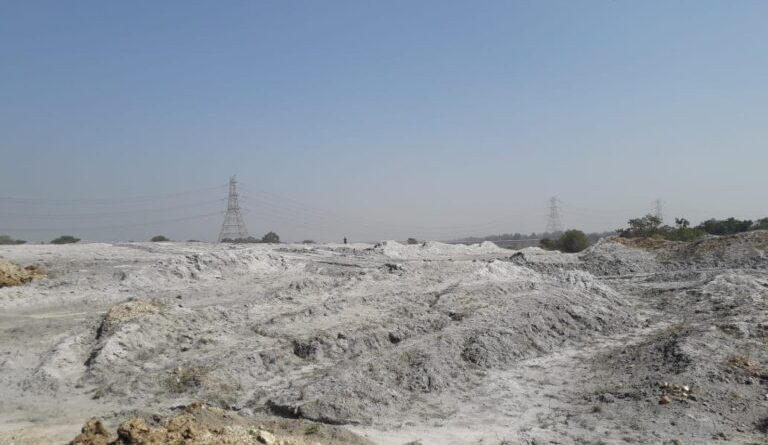fly ash significantly disrupts the daily lives in Chhattisgarh.
Alok Prakash Putul
Raipur
In Chhattisgarh, the daily release of millions of tons of fly ash from thermal power plants is significantly impacting the lives of local residents. Despite efforts to manage this issue, the scale of the problem remains daunting. Fly ash, a byproduct of burning coal in thermal power plants, poses various environmental and health hazards, making it a pressing concern for communities across the state.
The coal found in India typically contains 30-40% ash content. When burned in thermal power plants, this coal releases not only particulate matter 2.5 (PM 2.5) but also a range of harmful substances, including black carbon, arsenic, boron, chromium, lead, silicon dioxide, aluminum oxide, ferric oxide, and calcium oxide. These substances constitute the fly ash that is emitted into the air.
Despite efforts to repurpose fly ash for activities such as road construction, brick-making, or filling closed mines, the sheer volume of ash generated every day presents a challenge. The storage ponds designed to contain this ash are filling up rapidly, posing a risk of overflow and further contamination.
Summers exacerbate the situation, particularly in cities like Korba and neighboring villages, where ash storms spread over vast distances. During the monsoon season, heavy rainfall washes large quantities of ash into water bodies, contaminating fields and water sources.
Local residents, such as Dharamraj Dewangan from Korba, describe the adverse effects of fly ash on their daily lives. Dust and ash accumulate on rooftops and courtyards, causing respiratory issues and irritation to the eyes and throat. The pervasive presence of fly ash in the environment has become a constant concern for communities living near thermal power plants.
Efforts to address the issue of fly ash management have been ongoing for years, with guidelines issued by the Ministry of Environment and Forests (MoEF) in 1999. These guidelines aimed to achieve 100% utilization of coal ash produced by thermal power plants. However, despite these directives, many states, including Chhattisgarh, have struggled to fully implement the measures outlined.
Data from recent years reveals the staggering quantities of ash produced by thermal power plants in Chhattisgarh. In the fiscal year 2021-22 alone, 31 thermal power plants in the state generated 25 gigawatts (GW) of electricity, producing 44.95 million tons (MT) of ash, the highest in the country. Despite this, only 35.28 MT of ash were utilized, highlighting the significant gap between production and utilization rates.
As of March 31, 2022, the total ash released from power plants across the country amounted to 1,734.01 MT, with Chhattisgarh alone accounting for 236.43 MT. The sheer magnitude of ash production underscores the urgency of finding effective solutions to manage and utilize this byproduct of coal combustion.
Efforts to contain and manage fly ash have led to the construction of ash storage facilities across the state. However, despite these measures, illegal dumping of ash remains a prevalent issue, particularly in districts like Korba, Raigarh, Janjgir-Champa, and Bilaspur. Power companies have been found to illegally dump ash in open fields, forests, drains, and ponds, further exacerbating environmental pollution and health risks for local communities.
Instances of illegal dumping have resulted in dismissals and fines imposed on power stations, but the practice continues unabated. In some cases, entire ponds have been filled with fly ash, leading to the loss of vital water resources and exacerbating environmental degradation.
Efforts to address the issue of fly ash pollution have garnered attention from both environmental activists and legal authorities. The National Green Tribunal (NGT) has issued guidelines to address the detrimental effects of fly ash, while the Chhattisgarh High Court has appointed advocates to investigate related issues.
Social activists, such as Lakshmi Chauhan, have been vocal about the need for stricter enforcement of regulations governing fly ash disposal. Despite government directives to repurpose fly ash for land reclamation and other purposes, implementation remains lacking, leading to continued environmental degradation and health risks for local communities.
The health impacts of fly ash pollution are significant, with reports indicating contamination of irrigation water and adverse effects on crop productivity. Air pollution levels in areas like Korba exceed national standards, posing serious health risks for residents. High levels of particulate matter and other pollutants have been linked to respiratory issues, cardiovascular problems, and other health complications among local populations.
Data from health authorities reveals alarming levels of pollutants in areas affected by fly ash pollution. In some parts of Korba, levels of silica, nickel, lead, and manganese far exceed permissible limits, leading to various health issues affecting residents’ nervous systems, lungs, respiratory systems, hearts, kidneys, skin, blood, and eyes.
Local residents have experienced firsthand the detrimental effects of fly ash pollution on their health and well-being. Increased hospital visits for respiratory issues and other health complications have become commonplace, underscoring the urgent need for action to address this environmental crisis.
Government officials acknowledge the challenges posed by fly ash pollution but dispute reported figures on the extent of the problem. Efforts to dispose of ash through partnerships with mines and other measures are underway, but significant challenges remain in enforcing regulations and ensuring compliance with environmental standards.




